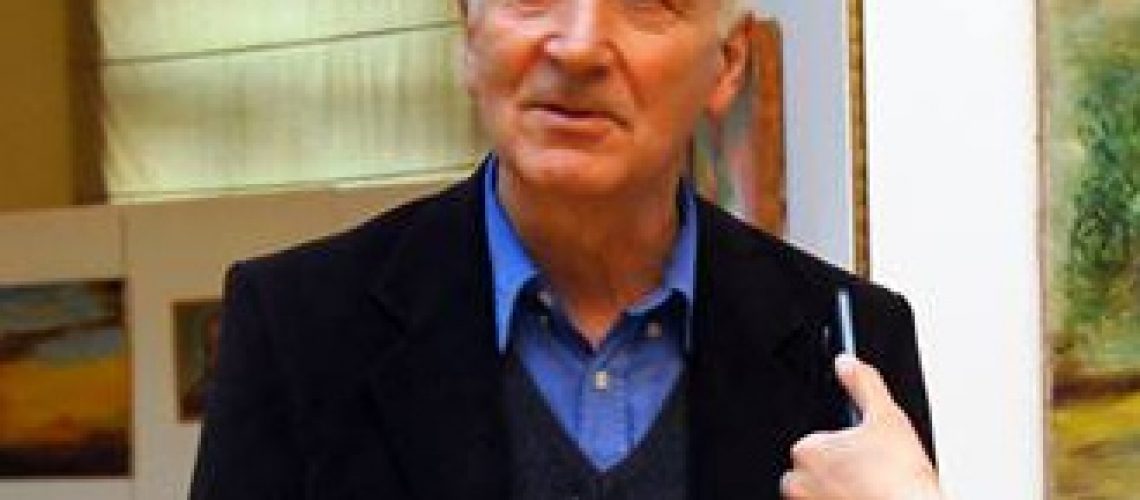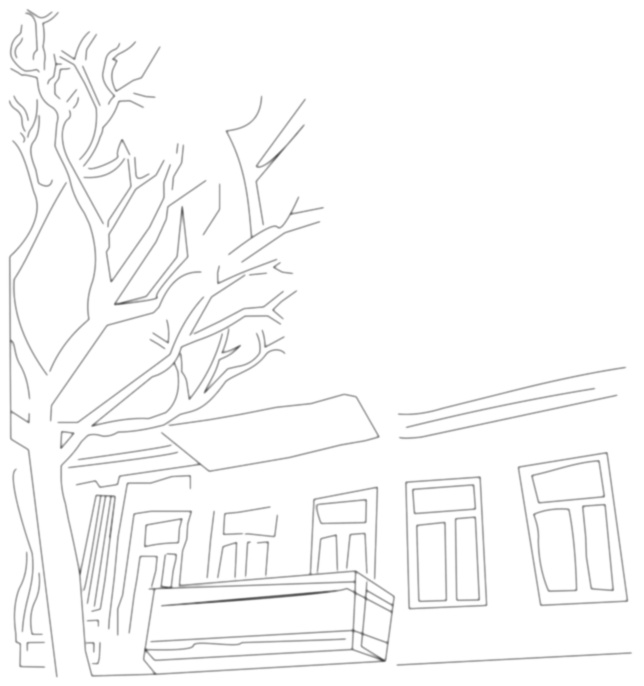Following again the discourse focused on art, many elements of the conversation can indeed be traced back to the original summary written down by Gabriele, with the difference, in the opinion of the writer, that the mention of his sons preceded, and did not follow, such a discourse.
Irakli associated from the beginning the realism in art with his son Koka, an approach for which indeed is necessary a specific preparation and “hard work”, and a more unconstrained expression of one’s artistic talent to his son Niko (a nickname for Nikoloz, while Nikoloz itself is a “placeholder”, a “replacement”, a substitute, for the official name, which is …).
Irakli recognized an extraordinary talent for colors to his son Niko, who indeed preferred to deploy his talent, and to use his time, creating wooden accessories with artistic value, that is not renouncing the artisan and material aspect of art which at the moment, and probably due to his young age and education, he feels as necessary.
Irakli also mentioned something that Tommaso found very significant and in certain way new. He said to prefer himself painting landscapes and nature and eventually flowers, because nature is, almost by definition, a subject where the artist can find more freedom, and which is less saturated, in some way, of conventional “mannerisms”, which on the other hand, in some way by definition characterize the human field.
In this sense, Irakli often says about himself to not being “a great portraitist”, both in adherence to the statement above expressed, that is that he feels himself in the middle between the realism in art, and an unconstrained expression of one’s talent, and because indeed being “a great portraitist” requires confronting oneself with the human sphere, or continuously, or as a requisite, and with all that is conventional, which indeed the dreaming soul of Irakli, does not refuse absolutely, but tends to avoid.
In other words, Irakli defines himself not “a great portraitist” partly for the kind of preparation (he did not have a rigorous artistic preparation, and he came to art instinctively or following biographical events) and partly as an aspiration, and for something indeed intimately connected to his art, which is not such as to be considered “worldly” (“mondana”), not something connected to “man”, and his world, but rather as something evocative and imaginary related to, eventually, another world and, still eventually (except that his paintings are in some way lonely, deserts, as lacking of a known presence) — other beings.
Irakli said that flowers represent, in his opinion, a subject where the absolute lack of artistic constraints almost converges, and in this view he mentioned the overwhelming artistic production on this subject of his son Niko (it is indeed correct the mention of his participation to an exhibition at the National library of Tbilisi, with 70 or 80 paintings on this subject).
To express this idea, the lack of constraints, of mannerism on that specific subject, Irakli used a specific expression, or he expressed the concept in turn in some unconventional way, but I who now write, at a certain distance from the event, cannot remind it precisely. Perhaps he used the word “format”, to express the set of conventions related to a specific subject, or some other more significant word and expression, which indeed had the effect to awaken the attention of the interlocutors.
It is possible that, for his predilection for an artistic expression based on colours, he viewed to the flowers, as a subject at the same time place of election, almost of origin, of colours, and of the unconventional in art, a territory and a realm where the human sphere does not dare, or must not dare to intervene or influence: indeed one of the dominant traits of the character of Irakli is delicacy, which is perfectly conform to all this conception.
Whilst Irakli was doing such discourse, he was indeed sliding his long photographic gallery on his smart phone, showing in a first moment, as reported by Gabriele, his sons’ paintings, and in a second moment his own paintings.
He therefore showed some hand-made art objects created by Niko, some Koka’s painting (of which, however, Mattia will have had — and he has at the moment of the writing of this story — a better idea following a visit in the house of Irakli himself), he probably showed some Niko’s paintings or drawing representing his artistic talent as painter (a path that indeed he regrets to him) and equally likely a painting which he sold for a discrete amount of money to a Turkish customer: Tommaso did not follow the discourse at this point because he was not interested to the commercial/promotional aspect of the artistic presentation, or he did not feel to be provided by Irakly with all the details which would have made this passage interesting. Perhaps the information of “time” and the “place” of the episode were missing, so that Tommaso was just non able to represent the related scene in the proper way.
Irakli also added that still his son Niko (upon which was focused a good part of the conversation) participated to a street market, with a stand for selling his artistic works. This time Tommaso was able to represent appropriately the scene, settled down in Rustaveli avenue, and asked how much these stands costed during the manifestation. Irakli answered that they costed 300 hundreds GEL for the entire duration of the manifestation, lasting 2 or 3 days, and Tommaso said that it appeared to be a great price, considering that in Europe, for similar activities, one has to invest amounts of money considerably greater.
(then one asks himself why home-made products are so expensive, and the answer is that the prices have to cover the bad management of the municipality)
Then it is possible that Irakli showed some of his paintings from his smartphone’s gallery. Among many beautiful and significant paintings he had, he showed one representing “Hillary Clinton” (or a figure which he presented as such) in front of the US’s White House.
Irakli said to Mattia and Gabriele that Tommaso did, regarding that painting, an observation quite interesting, that is that the subject of the scene (“Hillary”) was a little “flat” and lacked of some depth that on observer would expect. Irakli appeared to agree with this information, even if (obviously) to take the subsequent measures requires additional work, and the preparation of an “art studio” which Irakli did not have yet ready at the moment.
Besides that, Tommaso admired of this painting the enthusiastic and elevated look of “Hillary” (the subject of the painting, or the human figure of the painting), and he thought that whatever person will be very gratified of being painted with such look (“sguardo”) and that often, elapsed the times of youth, when you cannot distinguish the dreaming upon the world, from the world itself, such look is replaced by something much more pragmatic and “terrestrial”, which at bottom does not honor man (and the woman).
Tommaso also said that the dress of “Hillary”, in this picture, reminded the dresses of some Bronzino’s painting, very elaborated and complex.
Then, it is possible that there was some other mentions to artists. Tommaso, probably in a first time of the conversation (when Irakli was talking about the different styles in art, and about his own style) mentioned Francis Bacon, as an artist to be regarded. (and he described his style shortly)
Then, still in accordance with the report written down by Gabriele, Irakli addressed to Gabriele and Mattia asking more about themselves, and actually about their city of origin. Mattia answered, as always “from a village besides Perugia”, and Gabriele as always answered “from a village near Milan” (in the latter case giving a sense of proximity to a famous Italian metropolis of international value).
When Irakli heard the word “Perugia” he had a lightning and told something like “Perugin…” (premised by something that I don’t remember) and when Tommaso heard the word “perugin” he laughed perhaps a little inappropriately for the second time thinking to the chocolate producer (for which Perugia is indeed also famous).
But the wise Irakli was indeed referring to Pietro Vannucci called “perugino”, as also reported by Gabriele, and following, probably, as also mentioned, he talked about “his school memories” and “other Renaissance Italian artist”.
It is possible than then Tommaso asked if he was remembering some other Italian artist, and then Irakli did a note about memory of great interest and acumen.
It was about the different kind of memories, that one can have, and the fact that one’s memory is naturally addressed to very specific subjects. But of this note I cannot remind more, and whatever element I would add would be totally arbitrary and not conform to the facts or to the ideas and intention of Irakli, so that I can rightly abstain of striving more.
At the end of the meeting — during which Irakli, in his beautiful and consistent figure, remained well wrapped in his clothes, because the office was oddly cold — Irakli stood up with the plan to head to an exhibition (fixed at 17.00 in the city centre) and Tommaso went behind him.
Tommaso, that day, had the soul engaged in some other important task, so, while he was walking with him in direction of the bus stop of Dolidze st., his attention was captured by different and remote things, and he was not able to thank appropriately Iralki Aivalishvili when he went away, or eventually to follow him.

